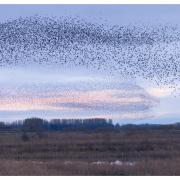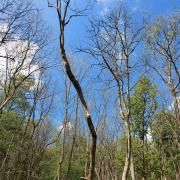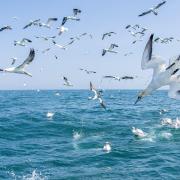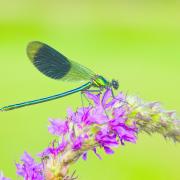How do you protect the nature and wild places of Britain’s largest county, while simultaneously looking to the future in the face of immense global environmental challenges? For the last seven decades, one charity in Yorkshire has done just that. Tom Marshall looks back.

It’s been a busy 70 years for the county’s largest nature conservation charity, Yorkshire Wildlife Trust. In a year that has also seen milestone birthdays for this magazine, and the world renowned, pioneering naturalist Sir David Attenborough, there remains plenty on the ‘to do’ list for almost 100 staff, 900 volunteers and countless trainees who now work to safeguard wildlife every day in God’s Own County.
Yorkshire Wildlife Trust remains one of the largest of the 47 county or country Wildlife Trusts based across the UK, but its beginnings were rather more humble – even if it did have some big name backers. It was a quiet and unassuming ‘bog’ woodland on the outskirts of York that was to be the catalyst for an organisation that today, counts more than 40,000 people among its supporters.
Almost within sight of their iconic factories, Askham Bog on the city’s Tadcaster Road had come to the attention of a certain Mr Terry and Mr Rowntree, due to its astonishing wildlife credentials and impending opportunity to be gifted to any organisation able to secure its future. Seeing this as too good an opportunity to miss, the leading chocolatiers of the time set about creating the ‘Yorkshire Naturalists Trust’, formed in spring 1946 with just 11 members, and only the second group of its kind at the time anywhere in the country. Just weeks later, the future of Askham Bog was assured, and a new charity had set down its roots.
By the late 1950s, membership had already increased to over 500 people and the Trust had also made another ground-breaking acquisition in the shape of Spurn Point, from the War Office, which 40 years later would become East Yorkshire’s only National Nature Reserve. The arrival of the 1960s saw the realisation that the Trust would have to operate from a single headquarters in York – with all activity prior to then conducted via countless volunteer living rooms. Two leading figures at this time were Spurn warden Barry Spence and Stephen Warburton, with the tireless efforts of the latter across numerous campaigns reflected in the Trust’s library of the same name at their current HQ in the city.

Without these crucial battle lines being drawn, the last 70 years may have seen the loss of some of Yorkshire’s iconic limestone pavements – a camping spot for Harry Potter and his friends in the series of feature films – the expanses of Thorne and Hatfield Moors under the peat digger’s spade, or a now thriving system of healthy rivers that previously couldn’t have welcomed the populations of otters they successfully host today.
The following decades saw a nature reserve portfolio that would rise to more than 100 sites across more than 3,000 hectares, including several internationally important locations, and more urban, accessible sites such as Potteric Carr near Doncaster. Extensive wetlands like Wheldrake Ings in the Lower Derwent Valley would contrast with the seabird cities and towering 400ft cliffs of Flamborough, which came under the Trust’s wing in the 1990s.
It was during the 2000s however, when a major shift in approach to wildlife conservation would start to shape the direction of all wildlife trusts – including here in Yorkshire – and one that now underpins the more pragmatic and holistic approach that drives the Trust’s work today.
Often described as looking out from nature reserves to the wider countryside, in contrast to standing on the edge of nature reserves looking in, the concept of ‘Living Landscapes’ has seen a fresh attitude to how we manage land for nature – and for the benefit of communities around it.

As the Trust enters its eighth decade, their work today focuses not only on more than 90 nature reserves, but on the land surrounding those sites; bringing together farmers and other landowners to create the missing links in the habitat ‘jigsaw’ around us. The simple aim of this principle being to ensure that nature has an opportunity to flourish in the face of bigger challenges such as climate change, reduced legislative and planning protection, and an increasing human population.
This landscape-scale approach sees wetlands and peat bogs that today are not only homes for wildlife, but also vital tools in how we tackle major events like flooding or the long term effects of an increase in carbon dioxide in our atmosphere. This approach is not restricted to the land either, with the Trust’s ongoing campaign for Marine Conservation Zones aiming to tackle the same gaps in how we protect wildlife under the waves, as our oceans battle a tide of rising temperatures, increases in litter and continued over-fishing in some areas.
While the Trust’s teams naturally focus on the here and now, there’s also a keen eye on the next generation too, with campaigns like the ground-breaking ‘30 Days Wild’ encouraging people of all ages and interests to pledge to make the simplest of interactions with nature each day throughout the month of June.
Underpinning much of this work is an alarming rise in so-called ‘nature deficit disorder’, which researchers have found to be linked to the rise in personal mobile technology, and an overall drop in children’s interaction with the outside world during the last two decades. The concern of course, is that without an appreciation and understanding of Yorkshire’s wildlife and wild places, who will be there to look after it in the future?
Alongside national campaigns like 30 Days Wild, National Marine Week and Wild About Gardens Week, the Trust is of course getting people close to wildlife on their doorstep right here in the county. With nature and countryside programmes now holding the primetime slots on our televisions, expectation from the ‘Springwatch’ audience is high, and the Trust is meeting that head on, shining a spotlight on locations like Spurn and Potteric Carr with exciting new visitor facilities planned in the months and years ahead. On the county’s breath-taking coastline, the Trust has been leading the way in showcasing ‘nature tourism’ – demonstrating that as well as simply brightening our day, wildlife can play a part in boosting our local economies too.
So as the Trust blows out the candles on its birthday cake there seems little time for reflection and in an ironic twist of fate, the nature reserve at the very foundation of the Trust – Askham Bog, may soon see their supporters once drawn into action with proposed neighbouring developments now threatening to enclose this reserve that kick-started seven decades of dedication.
But with so many years looking after Yorkshire’s spectacular landscapes and wildlife behind them, and a passionate team of supporters, you wouldn’t bet against the Trust making the difference once again – something that Messrs Rowntree and Terry would no doubt be proud of.



























